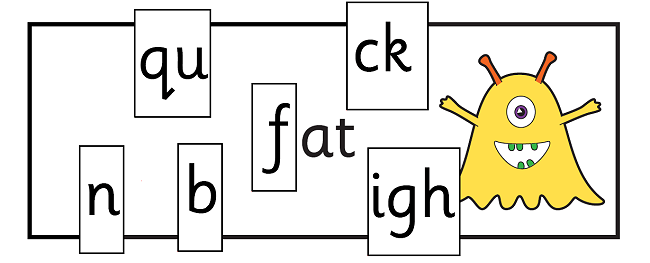There is power in games to both teach and remove fear – turn the Phonics Screening Check into a game.
Start with the simple, progress to the more complex, with lots of practice at each step. Kids love games and will happily practise key skills.
I have just come across the 2014 paper from the phonics screening check that is given to all children in the UK at the end of Year 1 (6-year-olds I think). There are a lot of nonsense words in it:
vol, teg, jat, ind, tull, tog, foid, shard, frem, cloin, bulm, harnd,
quiz, back, doom, short, freed, dress, fund, think,
jair, clain, yewn, tabe, clisk, thrand, strad, throy,
nigh, brown, main, rude, drink, crowds, splat, stripe, comic, giving, pumpkin, fighters
This looks like an excellent tool that anyone can use to check if there are sounds that children do not know, so that you can fill in any gaps. The scoring guide gives acceptable pronunciations of the nonsense words. Children who scored below 32/40 at the end of Year 1 were given extra help.
It would be useful to practise using the font as many letters have a “lead out”/kick on the end and “f” and “k” are a bit unusual.
Children faced with the phonics screening check could find it intimidating, but not if they have attacked previous versions with scissors.
Print the pages and cut them up to make games. Remember to only use letter-sound correspondences that your child has learned. Don’t expect them to know what you haven’t taught them. Make it just challenging enough to be fun and helpful, but not so hard that it becomes confusing or discouraging.
Possible games:
1. The nonsense words in the test all have delightful illustrations of “aliens”. “What is the alien saying? What language do you think he is speaking?”
2. If you print the test on thicker card, your child could cut out the nonsense words, each with its alien. Then cut up any of the other words to get single letters, or the groups of letters that you have taught and they need to practise. Put these over a letter or letters in any of the nonsense words. “What is the alien saying now?” E.g., teg => beg, deg, feg, keg, leg … or tag, tig, tog, tug … “Did the alien manage to say anything that we can understand, or is it all still nonsense to us?”
3. Cut the words in “half”. Try swapping them around.
E.g. sh/ard, cl/oin, d/oom => clard, shoom, doin or dard, cloom, shoin … “What is the alien saying now?” (Remember that you only need to teach “c” and “l” and how to blend them, not “cl” as a unit.)
Usually “teaching to a test” is seen as negative. However, for this test, it is all positive. Mastering these basic skills will set a child on the road to success.
The material is all available from https://www.gov.uk/government/publications/phonics-screening-check-2014-materials The tests are © Crown copyright and Crown information 2014. You may re-use them … free of charge in any format or medium …
The 2013 material is at https://www.gov.uk/government/publications/phonics-screening-check-2013-materials





{ 0 comments… add one now }